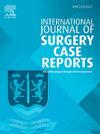Ozone therapy-associated pneumoperitoneum in a patient with low back pain: A case report
IF 0.6
Q4 SURGERY
引用次数: 0
Abstract
Introduction
Ozone therapy has been used for patients with low back pain due to disc herniation. Owing to its analgesic and anti-inflammatory properties, this method alleviates low back pain and often improves physical function through lumbar injection. Despite its therapeutic potential, the complications associated with ozone therapy are not yet fully understood.
Case report
A 57-year-old woman with a history of diabetes mellitus was admitted to the emergency department with acute abdominal pain and distension and chest pain, which occurred following her last session of ozone therapy. At first, the patient had been diagnosed with peritonitis based on initial symptoms. However, blood tests did not reveal any notable abnormalities. After identifying the presence of free air on the abdominal X-ray and the IV contrast-enhanced computed tomography scan of the abdomen revealed retroperitoneal and intraperitoneal air indicative of pneumoperitoneum and pneumoretroperitoneum. The patient was discharged in stable condition after five days of non-surgical and symptomatic treatment.
Discussion
This is a rare case of pneumoperitoneum and pneumoretroperitoneum, which also highlights a new complication of ozone therapy. Despite the exact pathophysiological mechanisms being unclear, the high pressure of ozone administration or technique may be the causative factors. Conservative management demonstrated favorable prognostic outcomes and an effective treatment response.
Conclusion
Spontaneous pneumoperitoneum presents with severe abdominal pain and the presence of free air in the abdominal cavity. Typically, it does not require surgical intervention. However, Conservative treatment resulted in a dramatic improvement in the initial clinical condition and decreased the amount of free air within the abdominal cavity.
求助全文
约1分钟内获得全文
求助全文
来源期刊
CiteScore
1.10
自引率
0.00%
发文量
1116
审稿时长
46 days

 求助内容:
求助内容: 应助结果提醒方式:
应助结果提醒方式:


